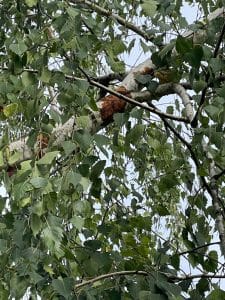Summer in Sonoma County is the time of year when you may see yellowing leaves or dead branches, usually at the top of the tree. The most common reason for this dieback is an infestation of Bronze Birch Borers. These boring insects affect Birch trees that are drought stressed. White barked Birch trees grow naturally in areas with summer rain and do not become drought stressed in the way that trees in Sonoma County do, especially in warmer areas like Santa Rosa, Windsor and Healdsburg.
The Bronze Birch Borer is a small dark colored beetle about 3/8 of an inch in size. The females lay eggs on the tree’s bark and the larvae chew through the bark into the sapwood or phloem and xylem tissue where they destroy the cambium area of the tree. This damage to the cambium interrupts the flow of water and nutrients and causes the decline of the tree’s branches.
How to prevent Bronze Birch Borers

Be sure not to prune your Birch trees during the summer months because the beetles may be attracted to pruning cuts when they are active. Schedule maintenance pruning for winter months when the insects are not active. Removal of newly formed dead branches can be completed in the summer to prevent the spread of the borers.
Treating Bronze Birch Borers
The University of California recommends two spray applications of a pyrethroid insecticide in April and late May to kill adults and larvae hatching from eggs before they have a chance to bore into the sapwood. A licensed Pest Control Applicator may be needed to apply the material effectively.
Another option for control is a systemic insecticide that can be drenched around the base of the tree or injected into the tree trunk. The material is then moved into the tree canopy through the sapwood of the tree. When the borers begin to attack the tree, the systemic insecticide will help to kill and control the pest. Systemic insecticides work best when the tree is in good health so early treatment is needed for the highest effectiveness. If you see yellowing or dead branches in your Birch trees give us a call at TreePro and one of our Certified Arborists will provide an inspection and recommendations for your trees.
[/fusion_text][/fusion_builder_column][/fusion_builder_row][/fusion_builder_container]






